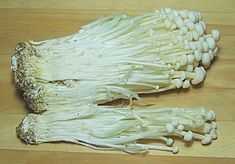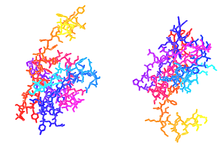Enokitake
| Flammulina | |
|---|---|
 | |
| Cultivated Flammulina velutipes | |
| | |
| Wild Enokitake, Flammulina velutipes | |
| Scientific classification | |
| Kingdom: | Fungi |
| Division: | Basidiomycota |
| Class: | Agaricomycetes |
| Order: | Agaricales |
| Family: | Physalacriaceae |
| Genus: | Flammulina |
| Species: | F. velutipes |
| Binomial name | |
| Flammulina velutipes (Curtis) Singer (1951) | |
Enokitake (榎茸, エノキタケ, Japanese pronunciation: [enokitake], /ɨˌnoʊkiˈtɑːkiː/), also Enokidake (榎茸, エノキダケ, Japanese pronunciation: [enokidake], /ɨˌnoʊkiˈdɑːkiː/) or Enoki (榎, エノキ, Japanese pronunciation: [enoki], /ɨˈnoʊki/),[1] is a long, thin white mushroom used in East Asian cuisine (such as that of China, Japan and Korea). These mushrooms are cultivars of Flammulina velutipes, also known by the name golden needle mushroom or lily mushroom.[2] Wild forms differing in color, texture, and sliminess are called names including seafood mushrooms, winter mushrooms or winter fungus, velvet foot, velvet stem or velvet shank.[3]
This mushroom is available fresh or canned, with experts recommending fresh enoki specimens with firm, white, shiny caps, rather than those with slimy or brownish stalks that are best avoided. It is traditionally used for soups, but can also be used for salads and other dishes. The mushroom has a crisp texture and can be refrigerated for approximately one week.[4]
Features
The mushroom naturally grows on the stumps of the Chinese Hackberry tree ("enoki" in Japanese), but also on other trees, such as mulberry and persimmon trees. There is a significant difference in appearance between the wild and cultivated types of the mushroom. Cultivated mushrooms have not been exposed to light, resulting in a white color, whereas wild mushrooms usually display a dark brown color. Cultivated mushrooms are grown in a carbon dioxide (CO2)-rich environment to nurture the development of long thin stems, whereas wild mushrooms produce a much shorter and thicker stem.
In the UK, the wild variety of the mushroom may be found from September through to March, hence the name Winter Fungus.
Names
| Flammulina velutipes | |
|---|---|
|
| |
| gills on hymenium | |
| cap is convex | |
| hymenium is adnexed | |
| stipe is bare | |
| spore print is white | |
| ecology is saprotrophic | |
| edibility: choice | |
The names enokitake (榎茸、エノキタケ), enokidake (榎茸、エノキダケ) and enoki (榎、エノキ), are derived from the Japanese language. In Chinese, the mushroom is called "jīnzhēngū" 金針菇 or "jīngū" 金菇. In Korean, it is called "paengi beoseot" (팽이버섯), and "kim châm" or "trâm vàng" are the terms used in Vietnamese.
Health properties

Enokitake mushrooms contain antioxidants,[6][7] like ergothioneine.[7] Animal testing has indicated possible applications in the development of vaccines and cancer immunotherapy.[8]
Research at the National University of Singapore, first published in 2005, stated that the stalk of the golden needle mushroom contains a large quantity of a protein, named "Five"/"FIP-fve" by the researchers, that helps in the regulation of the immune system. The mushroom also contains flammutoxin, a cytolytic and cardiotoxic protein[9][10] that has proven to be non-toxic when absorbed orally.[11]
Gallery
-

in Jan Kops - in Flora Batava : of afbeelding en beschrijving van Nederlandsche gewassen, Volume 10
-

Enokitake in Niederfinow
-
-
-
See also
- Edible mushrooms
- Japanese cuisine
- Medicinal mushrooms
References
- ↑ Dictionary.com (2012). "enokitake". Dictionary.com. Dictionary.com, LLC. Retrieved 14 May 2012.
- ↑ Orientalmart
- ↑ Shanghai Xuerong Biotechnology Co Ltd on Seafood Mushrooms
- ↑ "All About Mushrooms". Retrieved 2 Oct 2014.
- ↑ Ko JL, Hsu CI, Lin RH, Kao CL, Lin JY (1995). "A new fungal immunomodulatory protein, FIP-fve isolated from the edible mushroom, Flammulina velutipes and its complete amino acid sequence.". Eur J Biochem 228 (2): 244–9. doi:10.1111/j.1432-1033.1995.tb20256.x. PMID 7705335.
- ↑ Bao HN, Ushio H, Ohshima T (March 2009). "Antioxidative activities of mushroom (Flammulina velutipes) extract added to bigeye tuna meat: dose-dependent efficacy and comparison with other biological antioxidants". Journal of Food Science 74 (2): C162–9. doi:10.1111/j.1750-3841.2009.01069.x. PMID 19323731.
- ↑ 7.0 7.1 Bao HN, Ushio H, Ohshima T (November 2008). "Antioxidative activity and antidiscoloration efficacy of ergothioneine in mushroom (Flammulina velutipes) extract added to beef and fish meats". Journal of Agricultural and Food Chemistry 56 (21): 10032–40. doi:10.1021/jf8017063. PMID 18841979.
- ↑ "New look at two wonder mushrooms". National University of Singapore. 2001–2012. Retrieved 14 May 2012.
- ↑ Tomita T, Ishikawa D, Noguchi T, Katayama E, Hashimoto Y (July 1998). "Assembly of flammutoxin, a cytolytic protein from the edible mushroom Flammulina velutipes, into a pore-forming ring-shaped oligomer on the target cell". The Biochemical Journal 333 (1): 129–37. PMC 1219565. PMID 9639572.
- ↑ Lin, JY; Wu, HL; Shi, GY (November 1975). "Toxicity of the cardiotoxic protein flammutoxin, isolate from edible mushroom Flammulina velutipes". Toxicon 13 (5): 323–31. doi:10.1016/0041-0101(75)90191-9. PMID 54950.
- ↑ Tomita, Toshio; Dai Ishikawa; Takayasu Noguchi; Eisaku Katayama; Yohichi Hashimoto (8 April 1998). "Assembly of flammutoxin, a cytolytic protein from the edible mushroom Flammulina velutipes, into a pore-forming ring-shaped oligomer on the target cell". Biochemical Journal (333): 129–137.
External links
| Wikimedia Commons has media related to Flammulina velutipes. |


